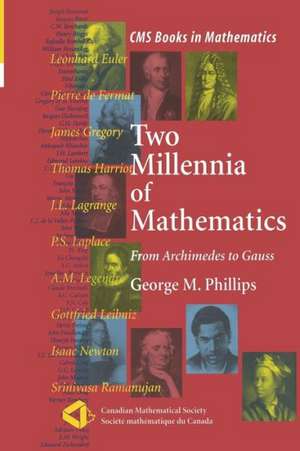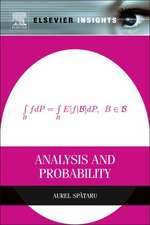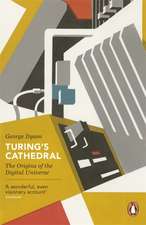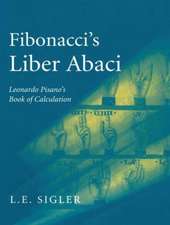Two Millennia of Mathematics: From Archimedes to Gauss: CMS Books in Mathematics
Autor George M. Phillipsen Limba Engleză Paperback – 3 oct 2012
| Toate formatele și edițiile | Preț | Express |
|---|---|---|
| Paperback (1) | 524.88 lei 6-8 săpt. | |
| Springer – 3 oct 2012 | 524.88 lei 6-8 săpt. | |
| Hardback (1) | 778.60 lei 6-8 săpt. | |
| Springer – 27 sep 2000 | 778.60 lei 6-8 săpt. |
Din seria CMS Books in Mathematics
- 20%
 Preț: 942.92 lei
Preț: 942.92 lei - 17%
 Preț: 429.86 lei
Preț: 429.86 lei - 15%
 Preț: 787.71 lei
Preț: 787.71 lei -
 Preț: 322.22 lei
Preț: 322.22 lei - 18%
 Preț: 780.97 lei
Preț: 780.97 lei - 15%
 Preț: 690.59 lei
Preț: 690.59 lei -
 Preț: 399.29 lei
Preț: 399.29 lei -
 Preț: 386.00 lei
Preț: 386.00 lei - 15%
 Preț: 644.30 lei
Preț: 644.30 lei -
 Preț: 368.24 lei
Preț: 368.24 lei -
 Preț: 392.37 lei
Preț: 392.37 lei - 18%
 Preț: 784.92 lei
Preț: 784.92 lei -
 Preț: 493.34 lei
Preț: 493.34 lei - 15%
 Preț: 443.91 lei
Preț: 443.91 lei - 15%
 Preț: 641.20 lei
Preț: 641.20 lei - 24%
 Preț: 699.00 lei
Preț: 699.00 lei -
 Preț: 389.88 lei
Preț: 389.88 lei - 15%
 Preț: 537.23 lei
Preț: 537.23 lei -
 Preț: 400.10 lei
Preț: 400.10 lei - 20%
 Preț: 547.87 lei
Preț: 547.87 lei -
 Preț: 395.85 lei
Preț: 395.85 lei -
 Preț: 399.29 lei
Preț: 399.29 lei -
 Preț: 397.01 lei
Preț: 397.01 lei -
 Preț: 391.79 lei
Preț: 391.79 lei -
 Preț: 483.05 lei
Preț: 483.05 lei -
 Preț: 497.00 lei
Preț: 497.00 lei - 15%
 Preț: 645.28 lei
Preț: 645.28 lei -
 Preț: 356.60 lei
Preț: 356.60 lei - 15%
 Preț: 639.41 lei
Preț: 639.41 lei - 15%
 Preț: 648.56 lei
Preț: 648.56 lei -
 Preț: 492.37 lei
Preț: 492.37 lei - 15%
 Preț: 478.05 lei
Preț: 478.05 lei -
 Preț: 389.49 lei
Preț: 389.49 lei - 15%
 Preț: 486.86 lei
Preț: 486.86 lei
Preț: 524.88 lei
Preț vechi: 617.51 lei
-15% Nou
Puncte Express: 787
Preț estimativ în valută:
100.45€ • 109.07$ • 84.38£
100.45€ • 109.07$ • 84.38£
Carte tipărită la comandă
Livrare economică 22 aprilie-06 mai
Preluare comenzi: 021 569.72.76
Specificații
ISBN-13: 9781461270355
ISBN-10: 1461270359
Pagini: 240
Ilustrații: XII, 223 p.
Dimensiuni: 155 x 235 x 13 mm
Greutate: 0.35 kg
Ediția:Softcover reprint of the original 1st ed. 2000
Editura: Springer
Colecția Springer
Seria CMS Books in Mathematics
Locul publicării:New York, NY, United States
ISBN-10: 1461270359
Pagini: 240
Ilustrații: XII, 223 p.
Dimensiuni: 155 x 235 x 13 mm
Greutate: 0.35 kg
Ediția:Softcover reprint of the original 1st ed. 2000
Editura: Springer
Colecția Springer
Seria CMS Books in Mathematics
Locul publicării:New York, NY, United States
Public țintă
Popular/generalCuprins
1 From Archimedes to Gauss.- 1.1 Archimedes and Pi.- 1.2 Variations on a Theme.- 1.3 Playing a Mean Game.- 1.4 Gauss and the AGM.- 2 Logarithms.- 2.1 Exponential Functions.- 2.2 Logarithmic Functions.- 2.3 Napier and Briggs.- 2.4 The Logarithm as an Area.- 2.5 Further Historical Notes.- 3 Interpolation.- 3.1 The Interpolating Polynomial.- 3.2 Newton’s Divided Differences.- 3.3 Finite Differences.- 3.4 Other Differences.- 3.5 Multivariate Interpolation.- 3.6 The Neville-Aitken Algorithm.- 3.7 Historical Notes.- 4 Continued Fractions.- 4.1 The Euclidean Algorithm.- 4.2 Linear Recurrence Relations.- 4.3 Fibonacci Numbers.- 4.4 Continued Fractions.- 4.5 Historical Notes.- 5 More Number Theory.- 5.1 The Prime Numbers.- 5.2 Congruences.- 5.3 Quadratic Residues.- 5.4 Diophantine Equations.- 5.5 Algebraic Integers.- 5.6 The equation x3 + y3 = z3.- 5.7 Euler and Sums of Cubes.- References.
Recenzii
"In an ideal university the staff would supplement the standard courses by offering lectures in which they talked about topics which they particularly loved at a level which the students could understand. And, in an ideal university, the students would flock to such lectures.
George Phillips' book consists of five short courses to be given at our ideal university. As the title is intended to suggest, the topics are treated with due respect for their history and all have their roots in the works of Gauss or earlier mathematicians. The level chosen is that of a first or second year student and the exposition uses the relaxed "explanation, theorem, proof"style of the best colloquium talks."
London Mathematical Society Newsletter, October 2001
"In five chapters (From Archimedes to Gauss, Logarithms, Interpolation, Continued fractions, More number theory), the author shows that many interesting and important results in mahtematics have been discovered by ordinary people and not onl by great geniuses. Each chapter includes the history of its topic with an interpretation of the mathematical problems. The book shows how and why some results in mathematics have been discovered or obtained, by following the steps of well-known mathematicians who discovered them. It is a useful source of mathematical material for teachers, undergraduate students, students and the vast numbers of amateurs who love mathematics."
European Mathematical Society Newsletter, Issue 41, September 2001
George Phillips' book consists of five short courses to be given at our ideal university. As the title is intended to suggest, the topics are treated with due respect for their history and all have their roots in the works of Gauss or earlier mathematicians. The level chosen is that of a first or second year student and the exposition uses the relaxed "explanation, theorem, proof"style of the best colloquium talks."
London Mathematical Society Newsletter, October 2001
"In five chapters (From Archimedes to Gauss, Logarithms, Interpolation, Continued fractions, More number theory), the author shows that many interesting and important results in mahtematics have been discovered by ordinary people and not onl by great geniuses. Each chapter includes the history of its topic with an interpretation of the mathematical problems. The book shows how and why some results in mathematics have been discovered or obtained, by following the steps of well-known mathematicians who discovered them. It is a useful source of mathematical material for teachers, undergraduate students, students and the vast numbers of amateurs who love mathematics."
European Mathematical Society Newsletter, Issue 41, September 2001















